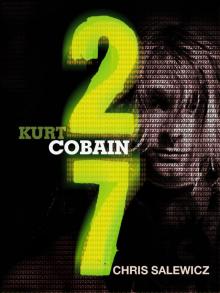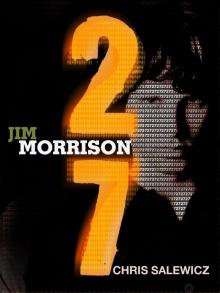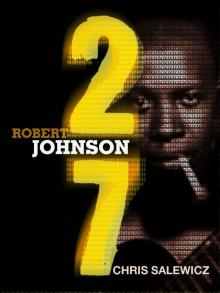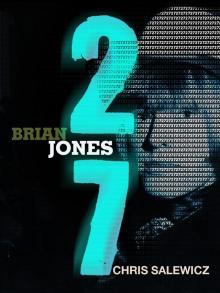- Home
- Salewicz, Chris
27: Robert Johnson
27: Robert Johnson Read online
Cover Page
Title Page
Copyright Page
27: Robert Johnson
Bibliography
Series Information
Footnotes
27: Robert Johnson
Chris Salewicz
First published in Great Britain in 2013 by Quercus
Quercus Editions Ltd
55 Baker Street
7th Floor, South Block
London
W1U 8EW
Copyright © 2013 by Chris Salewicz
The moral right of Chris Salewicz to be identified as the author of this work has been asserted in accordance with the Copyright, Designs and Patents Act, 1988.
All rights reserved. No part of this publication may be reproduced or transmitted in any form or by any means, electronic or mechanical, including photocopy, recording, or any information storage and retrieval system, without permission in writing from the publisher.
A CIP catalogue record for this book is available from the British Library
Ebook ISBN 978 1 78087 539 2
You can find this and many other great books at:
www.quercusbooks.co.uk
Chris Salewicz has been writing about music and pop culture for over 30 years. He was at the NME in the late 1970s and early 1980s and has written for The Sunday Times, The Face and Q magazine. His critically acclaimed books include Bob Marley: The Untold Story, Mick and Keith: Parallel Lines and Redemption Song: The Ballad of Joe Strummer.
I believe that my time ain’t long – ‘Ramblin’ on my Mind’
Robert Johnson, the legendary bluesman who died in murky circumstances from drinking poisoned whisky on 16 August 1938, is widely considered the godfather of both rhythm and blues and rock ’n’ roll.
In terms of contemporary culture, he is also the first on the list of immensely influential young men and women apparently fated to die at the age of twenty-seven following a ferocious flourish of talent. However, Robert Johnson was murdered; with the possible, and unlikely, exception of Rolling Stone Brian Jones, the only one on this eminent list to meet such a tragic end.
The shadowy nature of his passing, by poisoning, intertwined with the suggestion that he sold his soul to the Devil in exchange for his talent, has only added to his mystique as a dark figure – like a character from some Mississippi-set Jacobean tragedy reworked by Tennessee Williams. Yet nothing could be further from the truth. ‘Robert was one of those fellows who was warm in every respect,’ said his friend Johnny Shines,[1] ‘Robert was a fellow very well liked by women and men, even though a lot of men resented his power or his influence over women-people. They resented that very much, but, as a human being, they still liked him because they couldn’t help but like him, for Robert just had that power to draw.’
So celebrated is his legend that in 1994 Robert Johnson’s image appeared on the 29 cent US postage stamp, recognition of his more distinguished role as a black archetype of modern American mythology; a seemingly indispensible character onto whom since the early 1960s have been projected the dreams, fantasies, and aspirations of a myriad of largely white blues fans. These included a lonely young boy from Ripley in Surrey, England. ‘At first the music almost repelled me,’ wrote Eric Clapton, who in the mid-1960s almost singlehandedly brought Robert Johnson to the fore in Clapton: The Autobiography. ‘It was so intense and this man made no attempt to sugarcoat what he was trying to say, or play.’[2] In his biography Chronicles, moreover, Bob Dylan recalled that he broke down Robert Johnson’s lyrics by handwriting them onto paper; through this process he discovered ‘big-ass truths wrapped in the hard shell of nonsensical abstraction – themes that flew through the air with the greatest of ease.’[3] Meanwhile, the Rolling Stones replicated Johnson’s immortal ‘Love in Vain’ with great exactness on their 1969 album Let it Bleed.
The seemingly eternal suffering expressed in Robert Johnson’s lyrics held a library’s worth of meaning for those tormented by late-teenage angst. Certainly there is an element about the white-boy worship of Robert Johnson that suggests that for some of his fans he held a position like that of an honorary noble savage, as though he were the personification of some primitive ‘otherness’ through which they were put in touch with their own emotional truths.
Such a perception was reinforced initially because the bluesman’s legend was established when very few facts were known about him. Now, thanks to the assiduous efforts of music historians, much of Johnson’s life is reasonably well documented. The most enduring and most fanciful part of the myth of Robert Johnson, based on evidence supposedly gleaned from his writing and recording of the song ‘Cross Road Blues’, is that one midnight at the Delta crossroads of Highway 61 and Highway 49 by Clarksdale, Mississippi, he sold his soul to the Devil in return for his extraordinary and unique guitar-playing abilities. On close examination this is a legend found to contain not an ounce of veracity.
Indeed, believers in the fable even got the wrong man; the blues performer who had a distinctly mutated version of this experience was not Robert Johnson, but the unrelated Tommy Johnson, his friend and fellow musician. Tommy Johnson is best known for his songs ‘Maggie Campbell Blues’ and ‘Canned Heat Blues’, and claimed to have found his sudden guitar-playing skill in such a night-time crossroads ritual, one that is integral to many African animist religions, a relic of the slavery era widely practiced to this day in the United States, the Caribbean and South America.
‘If you want to learn how to make songs yourself, you take your guitar and you go to where the road crosses that way, where a crossroad is,’ said LeDell Johnson, Tommy Johnson’s brother, to the blues scholar David Evans about Tommy’s sudden guitar-playing skill and Tommy’s claims of its provenance, offering a severely truncated version of what is in fact an African spiritual practice. ‘Get there, be sure to get there just a little ’fore 12 that night so you know you’ll be there. You have your guitar and be playing a piece there by yourself . . . A big black man will walk up there and take your guitar and he’ll tune it. And then he’ll play a piece and hand it back to you. That’s the way I learned to play anything I want.’[4]
The ‘big black man’ in Tommy Johnson’s account is interpreted by impressionable white Christian listeners as ‘the Devil’. In other words, the ‘Devil’ is a big black man. And here is the unravelling of even more complex, deep-rooted prejudice; for if anything, the very notion of the black man selling his soul to the Devil at the crossroads is a white man’s superstition, reliant on such northern European notions as the Faust legend.
So as well as being a fabrication, it is also indubitably racist, an easy explanation for a white audience of the extraordinary abilities of a black man. In reality, however, the truth of the life of Robert Johnson is far more prosaic. For example, his visible ‘evil eye’, with which he was reputed to be cursed, was most likely nothing more than a cataract.
Brought into what became the United States by African slaves, animism-based religions and thinking remained ingrained in American black society; a number of interlocking, polytheistic religions provided a core belief system that, as time progressed, frequently intersected with aspects of Christianity. And as time progressed, animistic beliefs, which became known as ‘hoodoo’ (perhaps because the word seemed less threatening than ‘voodoo’), developed as part of the collective unconscious of the US black community.
In West Africa there are such crossroad gods as Eshu (also Esu) in Yoruban mythology, and Legba in Benin mythology – these are the figures who have been misinterpreted as the ‘big black man’ Devil character (inspired by the white man’s terror of the supposedly primitive, intertwined with guilt over the very notion of slavery). As a glance at Joseph Campbell’s The Hero with a Thousand Fac
es will attest, Eshu and Legba have global parallel figures: for example, Japan’s Chimata-no-kami, and ancient Greece and Rome’s Hermes and Janus. And the theme of selling one’s soul at the crossroads is prevalent not only in blues music like Johnson’s, but also in works of American literature such as Nathaniel Hawthorne’s ‘Young Goodman Brown’ and Washington Irving’s ‘The Devil and Tom Walker’.
The notion of Robert Johnson selling his soul to the Devil at the crossroads in some sort of mystical car-boot sale is extremely potent for young blues aficionados – like Robert Plant, who allegedly possesses a pouch of earth taken from the ground at the crossroads where Robert Johnson allegedly took part in such a ceremony. (Led Zeppelin’s 1969 track ‘The Lemon Song’ included the line ‘You can squeeze my lemon ’til the juice run down my leg’, from Robert Johnson’s ‘Traveling Riverside Blues’.)
Even the fact that Johnson recorded ‘Cross Road Blues’ only demythologizes the fable. He recorded the song in San Antonio, Texas, on 27 November 1936, his first recording session. But if you listen to the lyrics, they are about trying to hitch a ride, from the perspective of a young black man likely feeling imperilled by being alone at night in the murderously threatening atmosphere of the white-controlled, Ku Klux Klan-dominated American South. ‘Hellhound on my Trail’ can as readily be interpreted as the fear of a fugitive pursued by a lynch mob.
It’s all a metaphor. Eshu (and Legba) is a benign force, an encouraging entity to assist you in life’s journey. So why was it replaced by ‘the Devil’? Because this was the closest that followers of a polytheistic religion could come to explaining such characters as Eshu to followers of a monotheistic religion. Eshu is not an adversarial figure. Is the idea of selling your soul to learn a skill not too far from Carl Jung’s notion that artistic development is always at the expense of other areas of one’s character? Or could it also mean a period of vanishing into a metaphorical wilderness to find oneself?
Robert Johnson was supposed to have been a mediocre player, at first. After several years, it finally came together for him, and he gained his superior command of rhythm – and inflection – and in that combination something extraordinary began to happen.
But the very notion of Eshu is that he is the ‘trickster’; so are we being tricked here? For Robert Johnson was undoubtedly aware of the world of hoodoo. In his remarkable ‘Hell Hound on My Trail’, he sings that ‘hot foot powder’ has been sprinkled all around his door, keeping him with ‘a rambling mind’ – as the peripatetic Johnson was so often remembered by those who knew him. ‘Hot foot powder’, a mixture of herbs and minerals, was available from stores that dealt in hoodoo products; it was used as a means of ridding yourself of unwelcome individuals. Most likely, Robert Johnson’s mention of it is as a metaphor, but he would certainly have known his way around the products in a hoodoo store.
‘These stories,’ writes Catherine Yronwode, ‘seem to be prescriptions for a way to contact a specific, helpful spirit – and the specificity of the crossroads spirit’s power is quite apparent: he is a teacher spirit who will accelerate one’s mastery of mental, manual, and performing arts. The man at the crossroads does not steal your soul or condemn you to perdition or make any unholy bargain with you. He takes your offering and then he teaches by example and transference of power.’[5]
As part of the legend of Robert Johnson is his pre-eminent position in Delta blues, it is worth pinpointing where this lies geographically. The Mississippi Delta, which is not really a delta but part of an alluvial plain, should not be confused with the Mississippi River delta, which lies some three hundred miles south of this area. The region connected to Delta blues consists of the north-west section of the American state of Mississippi, as well as adjacent parts of Arkansas and Louisiana, the section lying between the Mississippi and Yazoo Rivers.
Prior to the American Civil war, from 1861 to 1865, it was one of the richest cotton-growing areas in the United States, the cotton plantations dependent on the labour of black slaves. The area is still predominantly black. Following the abolition of slavery, cotton remained the principal crop; freed slaves were frequently allocated a small share (the origin of the ‘forty acres and a mule’ stereotype) of their former plantation and they would farm that section, very much dependent on, and vulnerable to, the largesse of the former plantation owner.
The homes of these former slaves were often places of abject poverty, exacerbated by a lack of sanitation and essential hygiene, with frequently no latrines. Moreover, the grim spectre of lynching loomed forever over the black population, especially males, a permanent threat to any ‘nigger’ getting above his station. Ill-educated and outnumbered, the local poor white community felt themselves under economic threat – local blacks could be employed for even less than themselves – and their resentment would sometimes find an outlet in membership of the Ku Klux Klan.
*
The facts about Robert Leroy Johnson are much clearer than the myth.
He was born on 8 May 1911 in Hazlehurst, Mississippi.
His mother was Julia Ann Major Dodds. In 1889, when she was fifteen, she had married Charles Dodds, who had been born in February 1865. Both of their parents had been born into slavery.
In 1900 the federal census listed this married couple’s children as twelve-year-old Louise, nine-year-old Harriet, eight-year-old Bessie, five-year-old Willie, four-year-old Lula and one-year-old Melvin Leroy. Two children had died of illness – not uncommon in those days – and two more children were born subsequently.
But Robert Johnson was not a consequence of Julia Dodds’s marriage; Charles Dodds was not the father.
Charles Dodds was relatively affluent and successful. He was a manufacturer of wicker furniture and also owned farming land outside Hazlehurst, Mississippi, which was south of the state capital of Jackson, outside the Delta. Yet his position hardly saved him from conflict with local whites. Specifically, in 1909 Charles Dodds fell foul of John and Joseph Marchetti, a pair of Italian businessmen who had settled in Hazlehurst. This strife was occasioned almost entirely by Charles and Joseph both enjoying the charms of the same local woman, Serena, a mistress with whom Charles had two boys. Fleeing a white lynch mob, Charles Dodds disguised himself as a woman and managed to make it to Memphis, Tennessee, 240 miles distant. There, still feeling unsafe, he changed his name to Charles Spencer. Soon Serena and her boys joined him in Memphis, followed shortly afterwards by most of the children that Charles ‘Spencer’ had had with Julia Dodds.
It would have been a very different life to the one they had experienced in the Delta; the world’s largest cotton and hardwood lumber market, Memphis was a rich boom town, on one hand sophisticated, on the other wild and often very dangerous. In 1921 Memphis was the murder capital of the United States, its homicide rate seven times that of the country’s average; guns and knives were pulled with abandon, and poison – that staple weapon in slave rebellions against white overseers – was a regular method of dispatching rivals.
Unhappy about the living arrangements of her husband, Julia Dodds remained in Hazlehurst with two of their daughters. Yet the Marchettis soon kicked them out of their home and land.
This was clearly a bad time for Julia Dodds, only compounded by the divorce that she and her husband underwent the next year, in 1910.
Julia, who was by now thirty-eight years old, then had a brief relationship with Noah Johnson, a local plantation worker who was ten years younger than her. Out of this relationship was born Robert Leroy Johnson.
The boy was born into a life of struggle. His father was no longer around, and Julia needed to make money simply to survive. Working as an itinerant cotton-picker, for more than two years Julia moved from camp to camp in the Mississippi Delta region, around Tunica and Robinsonville, with her youngest daughters, Bessie and Carrie, who cared for their half-brother, the baby Robert.
Showing compassion for their plight and their poor living conditions, Charles Dodds Spencer decided around 1914 that he would bring Ro
bert up along with his other children, all of whom were by now in Memphis, where they were joined eventually by Julia. Yet because of the birth of Robert, Charles Dodds Spencer refused to resume his relationship with her; Julia lived in the same household with her former husband and Serena, his mistress having now usurped her position in the family. However, there was apparently no tension because of this. In Memphis Robert’s elder half-brother, Charles Leroy, owned a guitar, and from time to time Robert would play on it. Having started out life as Robert Johnson, the boy now found himself named Robert Spencer, bringing further confusion to an already confused life.
Memphis may have been somewhat wild, but it was also a progressive city; a powerful and vocal local movement urged the education of young black children. Robert Johnson attended elementary school there, most likely St Peter’s, from 1916 to 1920.
Around 1920, however, Robert went back to live with his mother, who had returned south and settled in the town of Robinsonville, Mississippi, thirty or so miles from Memphis. When he returned to the Delta, even though he was not yet a teenager, the contrast between the sophisticated and exciting city of Memphis and the small towns of the Delta must have struck Robert Johnson forcefully.
But the sensual urbane flavour of Memphis lingered in him, its influence part of who he was. His song ‘From Four Until Late’ makes mention of the city, employing an identical melody to a tune by a Memphis musician, Johnny Dodd, whose 1920 hit was very similarly entitled ‘Four Until Late Blues’. He would return time and time again to Memphis; Robert Johnson’s later dapper appearance was always far more that of a Beale Street slicker than a Saturday night fish fry plantation worker – even when that was his actual occupation.
By this time Julia, now forty-five, had remarried, in October 1916, to twenty-two-year-old Willie ‘Dusty’ Willis. As a consequence Robert Johnson now became known as Little Robert Dusty, further confusing his identity.

 27: Kurt Cobain
27: Kurt Cobain 27: Jim Morrison
27: Jim Morrison 27: Robert Johnson
27: Robert Johnson 27: Brian Jones
27: Brian Jones